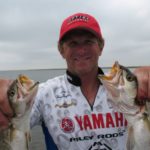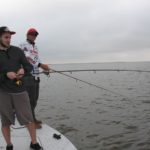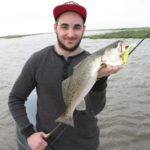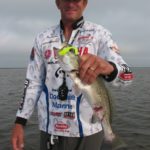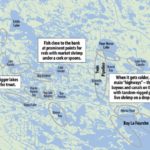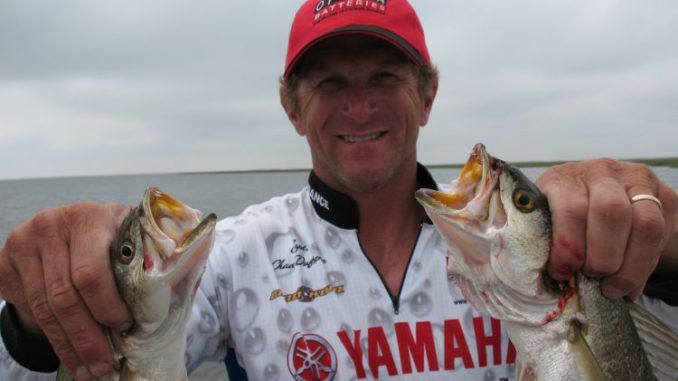
The pattern is so predictable that you’ll think you’re in a time warp when you start catching trout and redfish at Delacroix this month. Here’s how this guide loads up.
De’ja vu. We get the expression from the French, and it means “already seen.” It’s the feeling that you’ve been there before, experienced something previously or seen the same thing on some former occasion.
In my case, I was hoping to experience some fall fishing deja vu down in Delacroix Island, where trout are known to gather in big numbers in the fringe to mid-range bays as they make their annual winter migration into inside waters.
And, while it can correctly be said that fall fishing is fabulous all over Southeast Louisiana, there’s something special that goes on down in Delacroix.
It’s de’ja vu.
I persuaded Capt. Chad Dufrene (985-637-6357) to bring me, my brother Tony and one of his sons, Joel, out to see if we could find some speckled trout. So the three of us met Capt. Chad at his dock down at da island just before sunrise and loaded our gear into his 25-foot Majek bay boat.
His boat is a big, shallow-running, open vessel in Texas, but for some reason they just haven’t caught on down here in the swamps.
Of course, they might be more popular than I realize because I can only go by my own observations, or in this case, the lack thereof.
But they are definitely up for whatever you ask them to do. I’ve fished with Dufrene on numerous occasions, and the boat works just fine in our Louisiana coastal marshes and bays — and when you latch a 300-horsepower Yamaha on the rear end, it’ll get you where you want to go pretty quickly.
Dufrene had already loaded up the bait well with some frisky live shrimp from Sweetwater Marina, but he said that bait is not an absolute necessity this time of year.
“I bring them more as insurance, because we occasionally get those days when the trout just won’t bite the plastics and live shrimp is the only thing they’ll hit,” he said. “But those days are pretty rare this time of year. You can play it safe and bring some, but you don’t have to bring as many as you do for summer fishing.”
Plastics typically produce very well in the fall, whether you fish them under corks or just cast and retrieve.
Dufrene likes the Matrix Shad baits in either lemonhead, shrimp creole or the ultraviolet colors, while I came with a variety of H&H beetles and cocohoes and some VuDu shrimp, which I find hard to beat (especially since the company improved the hook).
Dufrene arms his customers with Penn equipment: 7-foot medium-action rods paired with 3500 to 4000 series Penn Clash reels spooled up with 20-pound Spiderwire Invisabraid.
All we needed now was to find some unsuspecting fish.
“We are in prime time here in November,” Dufrene said over the drone of the outboard. “Our fall season kicks off as early as late September, but by October we are going strong. And in November we are firing on all cylinders.
“The trout are following the shrimp as they push through the mid-range bays, and all our usual areas are red hot right now. Pointe Fienne, Bay Jack, Skippy, Bakers Bay, Little Crevasse, Bay Lafourche — are all producing plenty of trout.”
Dufrene snaked us through the marsh, and after a few minutes I had that de’ja vu feeling that came with recognizing familiar territory: the Twin Pipelines.
“The Pipeline itself is a good place to ambush trout as they wait to pick off the shrimp that are flowing with the tide through this canal,” Dufrene said, as he parked the Majek at an intersection and pointed at a chunk of grass in what was once the median between the two pipelines. “Throw as close to that grass as you can get and let your bait just fall down the ledge as you slowly retrieve it.”
I was tight-lining an red ice-colored H&H cocohoe, but the ¼-ounce jighead was too light to get the distance I needed.
Dufrene, on the other hand, made a long cast and was rewarded with an almost immediate hookup. In less than 30 seconds he put a nice trout in the box.
It would be the first of many caught that day, but not all of the fish came from one spot. In fact, far from it.
The trout were pretty scattered, and that spot ran dry after we managed a half dozen keepers.
So we worked our way around Four Horse Lake, and from there into Pato Cabello.
It’s a cat-and-mouse game.
“Oak River Bay, Bay Lafourche, Pointe Fienne, Four Horse, Skippy — just drift, and as soon as somebody catches a fish stick your Cajun anchor or Power-Pole and see if more fish are in the area,” Dufrene said.
The captain likes to fish prominent points where he sees bait or good current lines, and he sets the Power-Pole down far enough from the hot zone that a long cast will get you there.
“Don’t park your boat on top of where you want to fish,” the guide explained. “It’s a common mistake I see people make. Park off to the side and position your boat far enough away so you don’t spook the fish but close enough so everybody can cast to the strike zone.
“When we have mild to moderate weather you can drift the big fringe bays and lakes, and cast plastics under a cork. Cast all around the boat, and try long and medium-range casts.”
The goal is very simple — stick when you find fish and move when you hit a dry spot.
“You’re trying to locate fish,” Dufrene said. “Usually you’ll be able to pick up several fish in each stop. If you don’t get any action, pick up and resume drifting, and repeat that process each time you get a bite. If one body of water doesn’t pay off, move to another.
“Always look for decent water, look for tide/current lines around points and look for signs of bait in the water — mullet schools, shrimp jumping, etc. — and always look for birds.”
This pattern carries all the way until winter temperatures settle in.
“As November wears on our weather gradually, or sometimes suddenly, gets colder,” Dufrene said. “Once the genuine winter weather sets in, that’s when I’ll focus more on bottom fishing in the deeper highways such as Oak River, False River, Crooked Bayou and Bayou Fongera.
“There are a number of smaller bayous sandwiched between Bayou Fongera, Bay Shallow and the Twin Pipelines that have deep holes in the turns, and those are great places to toss tandem-rigged plastics and bounce them off the bottom.”
Once trout move deep, it’s vitally important to get your bait to the bottom.
He usually goes with a double rig for this work.
“I like to use a 3/8-ounce jig on the bottom line and a ¼-ounce jig on the shorter, upper line,” Dufrene said. “For some reason I have less tangles that way — and more action.
“The vast majority of the bites will come from the upper jig.”
If he doesn’t get bit, a technique change can make all the difference.
“On those difficult days when you just can’t get the fish to eat plastic, I’ll load a live shrimp on a drop shot rig and let that entice them to bite,” Dufrene said.
My advice: Head on down to Delacroix this month, and experience some de’ja vu, all over again.
Editor’s note: Capt. Chad Dufrene can be reached at (985) 637-6357 or dufrenesguideservice.com.
